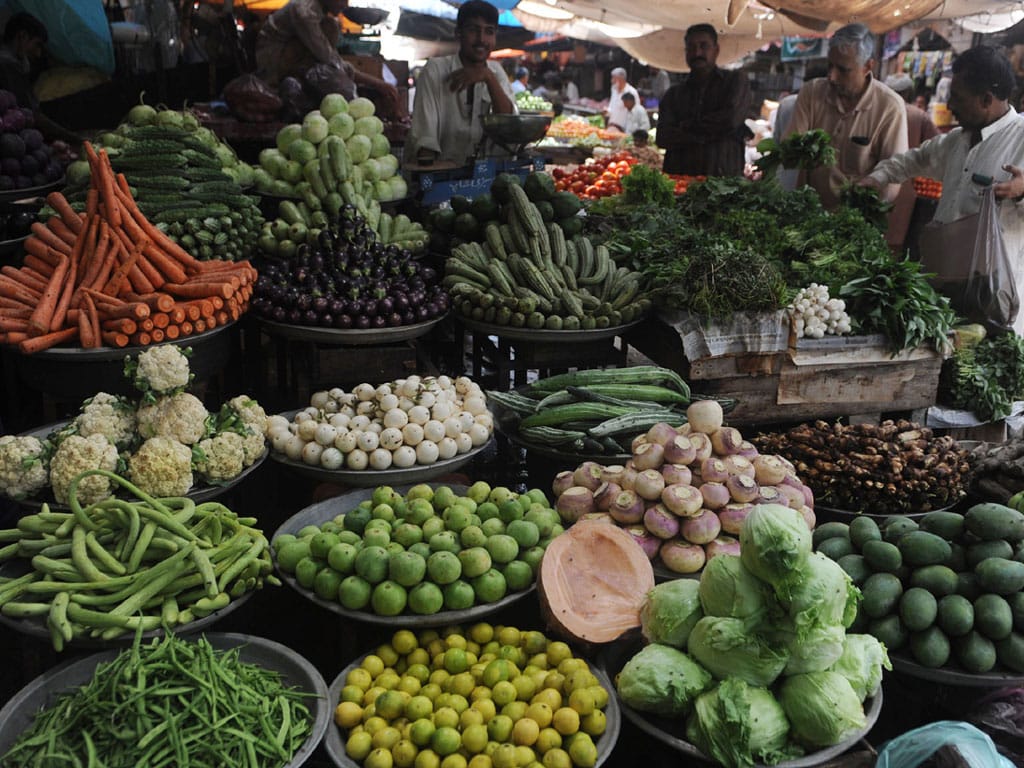Amid a hike in commodity prices, Pakistan’s consumer inflation was reported slightly lower as compared to last month. For the month of October, consumer inflation was reported at 8.9% from 9.0% in September 2020.
According to the Pakistan Bureau of Statistics, the Consumer Price Index (CPI) based inflation of October 2020 increased by 1.70 percent over September 2020, and increased by 8.91 percent over the corresponding month of the last year i.e. October 2019.
According to the data released by the Pakistan Bureau of Statistics (PBS), on a month-on-month basis, the top few commodities, which contributed to inflation include tomatoes (48.36 percent), onions (39.07 percent), chicken (26.62 percent), eggs (23.81 percent), wheat (8.39 percent), wheat products (8.07 percent), sugar (4.58 percent), wheat flour (4.1 percent), besan (2.89 percent), moong (1.69 percent, rice (1.45 percent), mash (1.26 percent), readymade food (0.98 percent), gram whole (0.85 percent), masoor (0.85 percent), potatoes (0.82 percent), gram (0.81 percent), and butter (0.78 percent).
Year-on-year top commodities, which contributed to inflation include tomatoes (66.93 percent), potatoes (53.14 percent), wheat (52.21 percent), eggs (43.32 percent), moong (40.94 percent), beans (37.91 percent, condiments and spices (36.6 percent), mash (35.64 percent), sugar (32.97 percent), wheat products (31.52 percent), wheat flour (24.67 percent), butter (22.74 percent), masoor (19.88 percent), chicken (18.22 percent), and vegetable ghee (15.76 percent).
However, year-on-year prices of some items decreased including fresh vegetables (9.09 percent), fish (8.99 percent), onions (8.35 percent), and fresh fruits (3.85 percent).
The CPI inflation general, increased by 8.9 percent on a year-on-year basis in October 2020 as compared to an increase of nine percent in the previous month, and 11 percent in October 2019.
On a month-on-month basis, it increased by 1.7 percent in October 2020 as compared to an increase of 1.5 percent, in the previous month, and an increase of 1.8 percent in October 2019.
The CPI inflation urban increased by 7.3 percent on a year-on-year basis in October 2020 as compared to an increase of 7.7 percent in the previous month, and 10.9 percent in October 2019.
On a month-on-month basis, it increased by 1.3 percent in October 2020 as compared to an increase of 1.3 percent in the previous month, and an increase of 1.6 percent in October 2019.
The month-on-month basis, the top commodities which varied from the previous month and contributed to urban CPI include tomatoes (48.36 percent), onions (39.07 percent), chicken (26.62 percent), eggs (23.81 percent), wheat (8.39 percent), wheat products (8.07 percent), sugar (4.58 percent), wheat flour (4.1 percent), besan (2.89 percent), moong (1.69 percent), rice (1.45 percent), mash (1.26 percent), readymade food (0.98 percent), gram whole (0.85 percent, masoor (0.85 percent), potatoes (0.82 percent), gram (0.81 percent), and butter (0.78 percent).
Items that registered a decrease include fresh vegetables (6.36 percent), fresh fruits (3.31 percent), and condiments and spices (2.39 percent).
Among non-food, increase in doctor’s clinic fee (MBBS) (2.57 percent), liquefied hydrocarbons (2.12 percent), furniture and furnishing (1.9 percent), hosiery (1.5 percent), household textiles (1.36 percent), therapeutic appliances and equipment (1.13 percent), motor vehicle accessories (0.89 percent), household equipment (0.88 percent), house rent (0.88 percent), household servant (0.87 percent), transport services (0.83 percent), and hospitals services (0.83 percent).
Year-on-year the top commodities which registered an increase; tomatoes (66.93 percent), potatoes (53.14 percent), wheat (52.21 percent), eggs (43.32 percent), moong (40.94 percent), beans (37.91 percent), condiments and spices (36.6 percent), mash (35.64 percent), sugar (32.97 percent), wheat products (31.52 percent), wheat flour (24.67 percent), butter (22.74 percent), masoor (19.88 percent), chicken (18.22 percent), and vegetable ghee (15.76 percent).
Items whose prices decreased include fresh vegetables (9.09 percent), fish (8.99 percent), onions (8.35 percent), and fresh fruits (3.85 percent).
The non-food times whose prices increased include personal effects (19.42 percent), water supply (18.92 percent), garbage collection (16.26 percent), doctor (MBBS) clinic fee (14.73 percent), woolen cloth (13.48 percent), cleaning and laundering (11.39 percent), furniture and furnishing (9.7 percent), marriage hall charges (7.55 percent), drugs and medicines (6.91 percent), hosiery (6.7 percent), construction input items (6.13 percent), and construction wage rates (5.78 percent).
Items whose prices decreased include liquefied hydrocarbons (12.31 percent), electricity charges (7.77 percent), and motor fuel (7.15 percent).
The CPI inflation rural, increased by 11.3 percent on a year-on-year basis in October 2020 as compared to an increase of 11.1 percent in the previous month, and 11.3 percent in October 2019.
On a month-on-month basis, it increased by 2.4 percent in October 2020 as compared to an increase of two percent in the previous month, and an increase of 2.2 percent in October 2019.
Main contributors to month-on-month top commodities which contributed to CPI inflation rural include tomatoes (64.99 percent), onions (58.39 percent), eggs (24.88 percent), chicken (23.14 percent), wheat (5.54 percent), sugar (4.89 percent), fresh vegetables(4.06 percent), fresh fruits (3.5 percent), wheat flour (3.28 percent), wheat products (3.07 percent), potatoes (3.05 percent), masoor (2.97 percent), dry fruits (2.73 percent), honey (2.5 percent), fish (2.38 percent), bakery and confectionary (2.38 percent), meat (1.76 percent), mash (1.6 percent), and cooking oil (1.47 percent).
Items whose prices decreased include moong (2.91 percent), condiments and spices (1.85 percent) and beans (0.71 percent);
Non-food increased: stationery (2.75 percent), liquefied hydrocarbons (2.65 percent), newspapers (2.4 percent), construction input items (2.13 percent), hosiery (1.71 percent), plastic products (1.49 percent), woolen cloth (1.37 percent), solid fuel (1.33 percent), textbooks (1.3 percent), mechanical services (1.18 percent), transport services (1.07 percent), doctor clinic fee (1.02 percent), household textiles (1 percent), products for personal care (0.89 percent), and education (0.88 percent); and Decreased: electricity charges (2.33 percent).
The Wholesale Price Index (WPI) inflation on YoY basis increased by 5.1 percent in October 2020 as compared to an increase of 4.3 percent a month earlier, and an increase of 13.3 percent in October 2019.
The WPI inflation on an MoM basis increased by 2.9 percent in October 2020 as compared to a decrease of one percent a month earlier, and an increase of two percent in the corresponding month (October 2019) of last year.





















